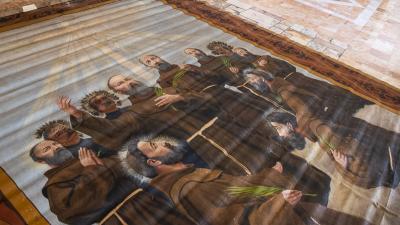
A display of items from the ancient pharmacy of the Custody of the Holy Land was inaugurated at Saint Savior's Monastery. A series of vases and ancient books preserve the memory of the place that is still well known throughout the world, and whose objects have been exhibited in famous museums, such as Versailles. Known since 1353, the pharmacy was important throughout the territory, because for a long time, it was a unique reference for caring for the sick in Jerusalem. The exhibit, which was organized with the support of the ATS Pro Terra Sancta Association, was inaugurated on November 30 and will be open to the public until December 8 from 10 a.m. to 5 p.m.
The pharmacy of the Custody of the Holy Land has long been the subject of study of Paola Brusa, a professor at the University of Turin, who, at the opening of the exhibit, announced the results of her research. At the conference, she explained her plan for the museum exhibit at the Terra Sancta Museum, specifically for the vases and objects from San Savior's pharmacy. A delegation represented the City of Turin, whose involvement aims to collaborate with the opening of the Terra Sancta Museum, and it is the result of PMSP project. Carried out by the Italian Consulate through support of the Ministry of Foreign Affairs, the PMSP (Palestinian Municipalities Support Program) supports Palestinian municipalities through the help of Italian cities. Also present at the conference was Antonio La Rocca, the program director who worked with this project as it related to cultural heritage.
“Researching the pharmacies and going around the world, I always try to understand what they did, how they lived, and the objects tell us a lot,” explained Prof. Brusa. “This place was a landmark for curing diseases. Having a pharmacy meant that they could prepare the medicine, instead of waiting for it to come from overseas.” Dr. Marco Parenti, who was visibly moved in front of the objects of his research, as well as Dr. Pierangelo Lo Magno, an expert in the history of the pharmacy, also collaborated. An examination of the vases and of the components of the medicines has led to the production of a multimedia laboratory.
Sara Cibin, from ATS, also participated in the exhibit. She was responsible for selecting its pieces, along with the restorer, based on the what was represented by the schools and the different typologies. “The vases tell the history of the Custody and the important role that the Franciscans played in the Holy Land,” said Sara Cibin. The exhibits are representative of a period from between the seventeenth and eighteenth centuries, and they come from Venice, Savona and Turin.
“We are very pleased that the city of Turin collaborated with us, and we are also open to suggestions, which should be discussed with those who are studying the museum project,” said Fr. Eugenio Alliatas, the archaeologist of the Custody “The museum project is being carried out in stages. It is divided into three sections: the multimedia section, located at the site of the Flagellation, which has already been open for a few months. Then, there is the archaeological section, which is being renovated, and which we hope to complete by next year. Finally, there is the historical and artistic area that will be set up at Saint Savior's monastery, with pieces from the Museum of the Flagellation, like those from the pharmacy, as well as other new pieces.”
Beatrice Guarrera




